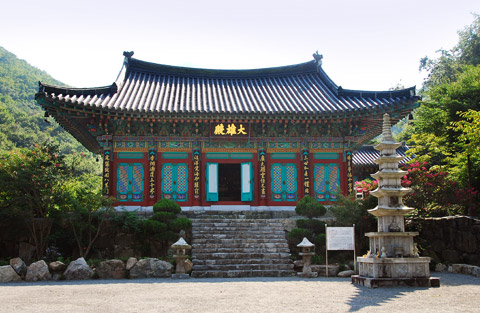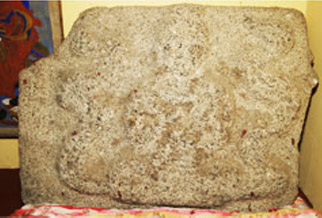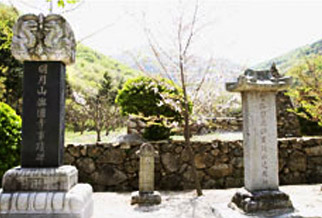Tour
- Tour
- Tourist site
- Heungguk temple in Myeongwol temple site
Heungguk temple in Myeongwol temple site
Myeongwolsa site (Gangseogu site, Busan site collection)

According to the ancient document called
The temple was burned down during the war with Japan, and it was rebuilt during the 10th year of King Gwanghaegun's ruling. When the second reconstruction was performed, the roof tyle saying 'Gyeongangwonyeongapsinsamwolnamsaek' was found under the broken fence, and the year of Gyeongangwonyeon is referred to the year of 144 when king Suro ruled the country which proves that western buddhism was delivered to the country by the monk called Jangyuhwasang.
According to the inscribed monument writing at the temple in the Heungguk temple, the king Suro of the then country Garak welcomed the queen Huh by giving the big party on the high mountain track, and devoted the silk pants she wore to the mountain god when returing to the palace on the day.
Sawangsuk stone

When the Chilsunggak shrine of Heungguk temple was built at the estimated site of the previous Myeongwol temple, a piece of stone of stone pagoda made of granite and the other stone product were found. Each snake is inscribed at both sides of stone Buddha statue at the center of the surface of the stone piece and is seriously eroded but its carving skill is excellent. The size of the stone is 74cm wide, 52cm high and 15cm thick.
It is quite unique that buddha and snakes are carved together. Some say that this look is from the snake king called 'Muchillidia' which is often observed in 'Yayoodia' of India as it looks as if each snake coils the both sides of buddha focusing on meditation and it is also translated into the fact that the snake king protects buddha absorbed in nirvana. In additions, it can be the materials to prove that the ancient time Indian nation called Ahyuta exchanged cultures with Garaguk and can be the base to insist that the then Korea accepted the buddhism from the southern areas. Currently, the stone of Myeongwol temple is kept in Heungguksa temple.
Heungguksa temple(the site of Gangseogu, Busan Jimyeongchongram, Busan's place name collection)
The address of the temple is 498 San Myeongdong village Jisadong. The site of the temple is considered the old site of Myeongwolsa temple. The current Heungguksa temple was rebuilt in 1956. 'Garakguk King Taejo Younghuyuhuh statue' is built in the temple. The nearby site of current Heungguksa temple was said to be the site of the old time Myeongwolsa temple, but, the trace of the previous site can't be observed. However, a piece of stone tower surface stone made of granite excavated when Chilsunggak of Heungguksa temple was built and another piece of other stone product are kept. The stone tower surface stone is called Sawangsuk, snake king stone. One statue called Geumdongyeoraeipsang was found in Jan.,1983 and is kept in National Museum of Korea.
rise and fall of Myeongwolsa temple(the site of Gangseogu)

King Suro of Garakguk welcomed the queen Huh at Buindang(Yongwon rhee Woongdongmyeon), brought her here and defeated many subjects and spent one night with her at the mountain valley. The king named the mountain shining with moonlight Myeongwolsan mountain and called the temple Myeongwolsa temple later as thinking about what happened at the night when the moonlight shone the small temple. The king increased the size of the temple a lot and gave the land in front of the field to many.
That is why the temple thrived a lot and the number of monks who stayed there reached over 300 and it included a lot of small temples. But, the way to the then capital, Gimhaeeup, was located in front of the temple, therefore, over hundreds of customers visited the temple a day.
The monks became tired of welcoming visitors later, and whenever the visitor with nice clothing came, the monks treated him well and asked the way not to have visitors. One day, when a young visitor wearing nice suit came to the temple, the monks asked him the same question. He observed the monks carefully and then told them if they cut the mountain top sticking out into the temple, then no more visitors would come and left the temple without leaving any trace. The monks made the workers cut the mountain top the next day. And then, since the day, nobody came and a couple of monks died everyday. And, the monks who died at the temple in upper side were cremated at the upper side and those who died at the temple in lower side were cremated at the lower side.
Therefore, the cremation sites were called upside charnel house and lower charnel house, respectively. It has been said that the stones burned out are still remained at the site. The Myeongwolsa temple with a good origin perished in this way and the site is now empty and the bamboo forest is formed there.



